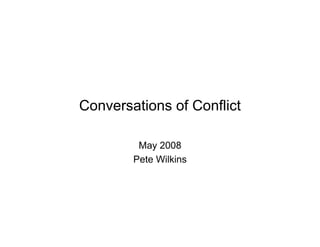Conversations of conflict
- 1. Conversations of Conflict May 2008 Pete Wilkins
- 2. A perspective to consider Conflict is necessary for all life. Conflict is the opposition of wills, principals, or forces. It is part of our biology, our psychology and our daily livesŌĆ”see conflict as a function of nature instead of pretending that itŌĆÖs a punishment. ~Terry Dobson
- 3. Ways of Viewing Conflict ŌĆó Magnifiers - People who see all conflict as equally threatening ŌĆó Misperceivers - People who misperceive conflict You donŌĆÖt see the whole ŌĆō Type 1 - Sees conflict where there is none iceberg ŌĆō Type 2 - Incorrectly reads the conflict situation ŌĆó Failed Perceivers - People who donŌĆÖt see it coming The ballplayer who doesnŌĆÖt see the block back on punt cover ŌĆó Clear Perceivers - See the situation clearly, see it as a function of nature, see it for what it is not what it appears to be.
- 4. 4 Rules to Perceiving Conflict Clearly 1. Take the past into consideration 2. Be on the look out for questions that are really statements. E.g., Are you sure you should be doing that? Means I donŌĆÖt think you should be doing that. 3. Observe the personŌĆÖs face (especially the eyes), manner, breathing, posture, etc. 4. Listen carefully to what is being said and, just as important, to what is not being said.
- 5. 6 Options to Conflict and their Symbolic Shapes 1. Push back, fight back, attack back Attacker Attacker You Yo u 2. Withdrawal u Yo You Negotiation Attacker requires two Adversary circles after 3. Negotiate the initial stage otherwise You You there is no Attacker negotiation. 4. Do nothing, ignore Like You negotiation Attacker but deception adds the element of 5. Deception untruth for the You sake of buying time. Attacker Like a revolving door 6. Blend (Confluence) you turn and move with the You direction of the attack





